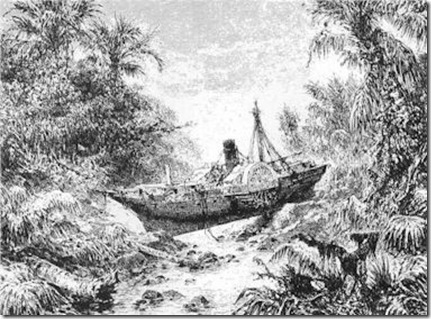| A tsunami carried this ship miles inland when |
The number of people killed by Indian Ocean tsunamis continues to climb by tens of thousands. In Indonesia alone, the official death toll is nearly 80,000--and there are warnings that it may go even higher.
Such heart-rending scenes have played out in Indonesia before. Some 120 years ago, tsunamis swept over Indonesian islands and claimed at least 30,000 lives when the Krakatoa volcano erupted.
Krakatoa: The Blast Heard
'Round the World
In 1883, the island of Krakatoa lay between the islands of Java and Sumatra, today part of Indonesia. Volcanic eruptions had formed the island over millennia, building up layer upon layer of erupted debris until Krakatoa's cone-shaped peak rose 6,000 feet (1,830 m) above the ocean.
Krakatoa had been quiet for more than 200 years before May 1883, when the volcano started expelling ash and grumbling ominously. It sputtered, on and off, for 100 days before exploding, four times, on August 26 and 27.
The climactic eruption, at around 10 a.m. on August 27, shot a column of ash 50 miles (80 km) into the air and produced an eardrum-shattering blast still in the record books as the loudest sound ever heard by modern humans. People heard the blast as far away as Vietnam, Thailand, Australia, and even Rodriguez Island--nearly 3,000 miles (4,800 km) away, across the Indian Ocean.
Rain of Fire
For people on islands near Krakatoa, the sounds were frightening enough--but it didn't take long for the sky to fill with ash or for pumice stones to start raining down. Krakatoa itself was uninhabited, but about 5,000 people on neighboring islands are believed to have died from the direct effects of the eruption, such as suffocating from the ash in the air.
For most, the worst was yet to come. No one realized it yet, but the island of Krakatoa had blown itself apart. As the magma rushed up through this vent in the crust of the Earth, the top of the 6,000-foot mountain collapsed into itself and most of the island sunk below sea level. Undersea disruptions roiled the ocean, displacing a huge volume of water. The water sloshed around and formed giant sea waves, known by the Japanese word "tsunami."
Four Waves
Each of the final four eruptions gave birth to a tsunami. The giant waves inundated smaller islands and then swept into Java and Sumatra. Already dazed by the rain of ash, people were shocked to see a wall of water suddenly bearing down on them. Most Javanese and Sumatrans lived right near the coast in homes made of rattan and thatched with palm leaves, so there was no place to seek shelter. All anyone could do was run.
"Looking out to sea, I noticed a dark black object through the gloom, traveling toward the shore," recounted an eyewitness on Java. "At first sight it seemed to be a low range of hills rising out of the water--but I knew there was nothing of that kind in that part of the Sunda Strait. A second glance--and a very hurried one at that--convinced me that it was a lofty ridge of water many feet high."
The survivors were plucky or lucky or both. One family survived by scrambling up trees when the water rushed in, then escaping to high ground when the water receded for a few minutes. Another fellow, asleep when the wave hit, simply stayed in bed and rode the wave until it left him--still in bed--atop a hill. But most people were caught in the killer waves, which reached 100 feet (30 m). At least 30,000 people drowned and 165 villages were swept away.
Around the World
The rest of the world was horrified and fascinated with the disaster. Scientists tried to collect and record all evidence of the blast for posterity. Surveying instruments from around the globe, they learned that shock waves from Krakatoa's eruption traveled around the Earth seven times before dissipating. Measurements taken in coastal areas indicated that the effect of the tsunamis traveled all the way to the English Channel.
And there was one more way that the eruptions affected many lives around the world. The millions of tons of dust that Krakatoa had cast into the atmosphere affected sunsets for months, intensifying their colors into vivid purples and mauves--some were even blue. Poets and painters tried to capture the ironic beauty, aware that it had come from a catastrophe that had claimed so many lives.
Colleen Kelly
December 30, 2004
Want to learn more?
See pictures of Krakatoa
http://www.npr.org/templates/story/story.php?storyId=4074651


No comments:
Post a Comment